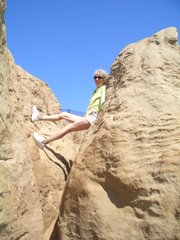
Target Students: Teens through Adults Proficiency Level: Advanced Beginner through Intermediate
Description: Rosetta Stone (RS) is a CD providing a multi-media approach to language learning. It uses pictures, sound on demand, and reinforcement of vocabulary learned by matching words with pictures to provide an authentic approach to the language. The program helpfully reviews what is learned, and provides scaffolding from words to conjunctions, such as "and" to the addition of placement of objects using prepositions; all while practicing the basic vocabulary provided.
In phase two of the Beginner's Addition, verbs are added to the nouns already learned. Using the sound print, learners are allowed to speak L2 into a microphone and receive a rating as to how accurate the imitation is.
Language skills targeted: Vocabulary, pronunciation, reading, writing, listening, and word recognition, as well as simple sentence formation.
Evaluation: In order to judge how effective RS would be in teaching beginners, I chose a language where I have limited familiarity--Mandarin. I would assume that Chinese learners would have problems similar to mine in using the English version of RS. Although it was easy to go from introductory to practice language sessions via the buttons, several problems presented themselves at once. There is a choice of pin-yin, which are alphabetic transcriptions of the characters with accents and umlauts. There is no chance to practice each sound individually or even to know what the diacritical marks mean, only the words. This is problematic as much of the difficulty in Mandarin (and Chinese dialect) interlanguage is pronunciation and the tone system. A simple example is the existence of sounds in Chinese, and not in English, such as "r" are very troubling. Sometimes it sounds like "L" or even "H" and sometimes faintly like "R." This pronunciation difficulty occurs in the first basic words presented to the learner.
The first words introduced are written in pin-yin, and there is no explanation why it takes seemingly three words to say "dog" or "cat." In other words the number and object counter are not explained. The same is true of "girl" and "boy," which are even longer. In looking at the Kanji characters, it is clear that number, counter, person, gender and the kanji for small are used for the word. However, you have to already know something about Chinese characters in order to decipher this. There are two sets of kanji available as buttons, and there is no explanation as to what the differences are.
The sound print of the voice tends to both help and frustrate, as even when the small indicator goes into the green, indicating native-like pronunciation, there is no way to know even if a "red" or "yellow" pronunciation is acceptable.
In summary, I feel that Rosetta Stone is a good way to begin and practice a language, but that teaching is necessary before turning someone loose with the program in order to direct efforts and ensure that frustration does not occur. It would be a good supplement to lessons in class, and provide early work with illustrations and vocabulary. A transcription of some of the language could be played in class, and students could work in groups to figure out what is being said, and then compare their anwers. Then they could be asked to say the opposite by replacing words, e.g., "dog" for "cat," and "boy" for "girl." For pronunciation, targetted work with the vocabulary and use of the sound print together could lead to more productive use of this instrument.






